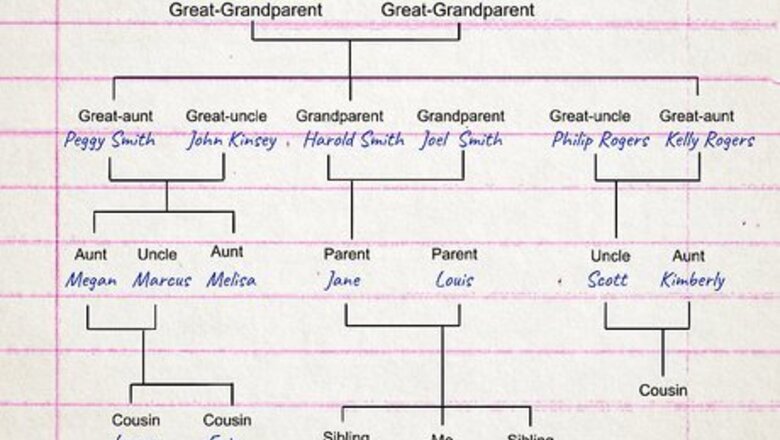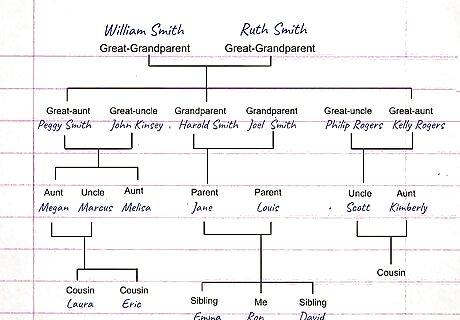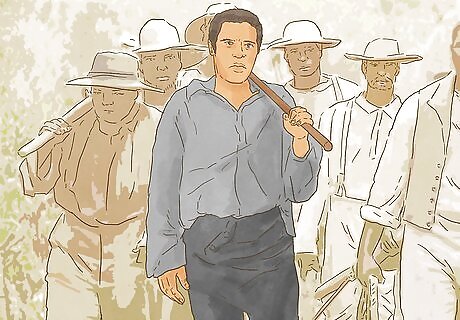
views
Writing a Family History

Create a family tree. A family tree is a great way to organize your family lineage, going as far back as you can. You may need to do research on your own or with help from your family members. Draw out the family tree on a large piece of posterboard and hang it on your wall. You could then use it as inspiration for stories about your family. There are also several online tools you can use to build a family tree. You may then print out the family tree and use it as a guide when writing about your family.

Let your family know you are writing about them. As you start your writing project on your family, you should consider letting your family know you are writing about them. Being upfront and telling your family may make it easier for you to dive right into the writing. You may sit your family down and let them know why you are drawn to writing about your family and why it is important to you. Having the conversation with them upfront can allow them to express any concerns they may have and allow you to talk about your project together. For example, you may say to your family, “I want to write about our family because I think we have a valuable story to share with others, a story about perseverance, sacrifice, and joy. I feel like a story like ours is not represented properly right now and I want to try to do it justice.”

Ask your family members if you can interview them. Start by gathering concrete information about your family straight from the source. Ask your family members if you can talk to them about their childhood, their upbringing, and their relationship to others in the family. You may take notes when you interview your family members or record them using a tape recorder or a video camera. Make a point of talking to the older generation in your family, such as grandparents, great aunts, or old family friends. Often, the older generation will have more information on your family history. You may need to interview your family members several times. At first, they might not know what parts of their past are important for your work. Over time, they will get a better sense of what kind of information you're looking for.

Look up information about your family in the public records. You should also use resources like public records online or in print to gather more information about your family. If your family has lived in the same place for several generations, you may look up the public records on your family’s last name to gather more information. You may also search for your family in the records at your local library or online in newspaper archives. If you are not sure how to search for your family in the public records, you may ask a reference librarian at your local library for guidance. You may also be able to speak to a representative at the city records office for advice on how to search for information.

Create character profiles based on your family members. To get writing on your family, start by creating characters based on your family members. Try to use as many biographical facts, personality traits, and details about your family as possible when creating these characters. You may create character profiles for each member of your family, including detailed backstories. For example, you may write a character profile for your father by writing, “60 year old Chinese-American man who came to America in the 1920s with his mother. Has a fascination with Chinese culture. Tends to speak up only when spoken to.” Keep in mind that you can share your impressions of your family members when you write about them. Make sure you clarify that you are writing from your perspective and try not to embellish any aspects of your family. You are writing non fiction, after all, not fiction.

Identify a conflict or theme in your family history. Having a central conflict or theme in your family story can help you stay focused when you are writing. You can also use this to keep the stakes of the story up and to build tension. There may be several conflicts or themes that you want to write about, or one central focus. For example, you may realize that you have always wondered why your father is so estranged from his family and why your grandmother left China in the first place to come to America. You may then use this question to structure and organize your story. You may also research your family with this question in mind.

Compile the family history. Once you have done your research and spoken to your family about your intent to write the family history, you should put together your family’s story. You may create a plot outline for the family history. Another option is to organize the story chronologically, beginning with your family’s origins and ending with their lives now. You may also have several major conflicts throughout the story, such as the time your grandmother ran off to marry your grandfather, or the moment your great-grandmother stepped on the boat to America. Use these conflicts and successes to propel the story forward and make the story engaging.

Revise the draft. Once you are finished with a draft of the story, share it with others and get feedback. You may share it with your family members to get their opinion on it. You may also share it with colleagues or friends who have experience in writing to get feedback. Be open to constructive criticism and revise the draft until it is at its best. Keep in mind your family members may have more edits or opinions on the draft than others. Try to accommodate their feedback, as you are writing their family history too. But you should also be willing to argue against their feedback if you think it will be detrimental to the overall story or not in keeping with the facts of the family history.
Writing a Personal Memoir

Do research on your family. Writing a personal memoir can be a fun and challenging way to write about your family. You may write a memoir as part of an assignment for a class or as a personal project. To write the memoir, you will first need to do research on your family history. This may mean interviewing your family members, searching through public records for information on your family, and creating a family tree. As you do your research, you should talk to your family about your plans to write a memoir. Let them know that you are researching your family for a book. Discussing the book with them will make the memoir more compelling and give you more information to work with. Keep in mind your family may not all be thrilled at the idea of the memoir at first, especially if they are nervous or worried about certain family details coming to light. Be tactful and patient with your family. Explain to them that you are writing a memoir from your perspective and that there is never one side to any story. Assure them that you'll let them read the final draft before you share it with anyone else.

Read examples of personal memoir. To get a better idea of how to approach your family’s story, you may read examples of non fiction work about family. You may focus on a writer that has a particular style or voice that you love. Or, if you are focusing on a specific family dynamic, such as an immigrant family story, you may read works that relate to that dynamic. For example, you may read: Angela’s Ashes by Frank McCourt The Woman Warrior by Maxine Hong Kingston Notes of a Native Son by James Baldwin Running in the Family by Michael Ondaatje The Glass Castle by Jeannette Walls

Focus on an issue you feel is important in your family. You may realize there is a specific issue or theme that keeps coming up when you talk to your family members and do research on your family. You may use this issue or theme to structure your story. You could also include your own reflections on the theme or issue in your piece about your family. For example, perhaps you notice the theme of assimilation keeps coming up in your research of your family. Or maybe there is the common issue of the women in your family overcoming obstacles to raise their children in America.

Make a plot outline. Creating a plot outline for your family’s story will help you stay focused and organized. You may make a loose plot outline that is broken into chapters or sections. Or you may go for a more traditional plot outline that is based on a plot diagram. Whichever approach you choose, having a plot outline can make diving into the writing of the story much easier. A plot diagram contains five parts: the exposition, the inciting incident, the rising action, the climax, the falling action, and the resolution. You can also try using the snowflake method, where you write a one sentence summary of the story, followed by a one paragraph summary, character synopses, and a spreadsheet of scenes.

Write about a family memory or experience from your perspective. In personal memoir, you are exploring your family relationships from your perspective. You should look at your family memories and your experiences with your family. Perhaps you realize there is a central conflict in your memories and experiences that you would like to explore further. Or maybe there is a particular memory you have from childhood that had a big impact on your family and the rest of your childhood. If you are writing about a memory or experience that is difficult to confront, such as a memory of abuse or neglect from a family member, you may need to write several drafts of the memory. Take your time and try to focus on sensory details in the memory. Be honest about how you feel about the memory on the page and don't be afraid to dig deep.

Revise your first draft. Once you have completed a draft of your story about your family, you should spend time polishing it until it is at its best. Read the draft aloud to yourself. Listen to how each section flows into one another. Pay attention to how you characterize each member of your family. Notice if there are any sections that feel flat or not as full of tension and conflict as they could be. You should ask yourself several questions as you revise, including: Do the characters in the story feel like fair representations of my real family? What's the conflict or theme of the story? Is it conveyed in a meaningful way? Do I need to include more reflections on my family from my perspective?

Get feedback on the draft from family and colleagues. You should consider showing the draft of your story to your family members, especially if you are planning to try to get the story published. Get feedback from your family members. Ask them if they feel the story is accurate of the family’s history. Be willing to listen to what they have to say and integrate their feedback into your next draft. Depending on what you write, some of your family members may be upset or unsettled by your story. This may occur if you are writing about a family secret or a difficult period in your family’s history. You should be prepare to defend or explain the choices you made in your story to your family members. You may also get feedback on the draft from close family friends or colleagues that you are close to. If you are looking for professional guidance on your draft, you may enroll in a writing workshop that focuses on non fiction and memoir writing. You may then get valuable feedback on your draft from other writers who are also exploring their family history. You may be able to find non fiction writing groups online or at your local college or university. If you have friends or colleagues who have experience writing memoir, you may approach them and ask if they’d be willing to start a writing group.
Writing About Your Family to Practice English

Use a writing prompt. If you are writing about your family as a way to practice and improve your English, you should use a prompt to get you started. You can create your own prompt or find a prompt online. You may challenge yourself to write a certain number of words about your family, such as 250 words. Or you may challenge yourself to write a certain number of sentences about your family, such as 10 sentences. For example, you may use a prompt like: “Think about your favorite family memory. Why is it your favorite? How did your family members make that moment special?” As part of the prompt, you could pretend you are talking to someone you just met who asked you to tell them about your family.

Create a first draft. When you write about your family, use the present tense and write in short, clear sentences. Identify all of your family members by name and discuss where your family members live. Use “brother, sister, mother, father, uncle, aunt, cousin, etc” to identify your family members. For example, you may write: “Let me tell you about my family. I have a mother, a father, two brothers, and one sister. We also have a dog named Pepper. We all live together in a house in Reno, Nevada. We have lived in the house since I was born. After they were married, my mother and my father moved to the house to start a family.”

Show the draft to others and revise it. Once you have completed the draft about your family, you should show it to others to get feedback. Show the draft to your teacher, your instructor, or to a native English speaker. Get feedback from them on your sentence structure, your word choice, and your spelling or grammar. Then, apply the feedback to the draft. You may end up adding in more details into the draft based on your teacher’s feedback. By the end of the revision process, you should have a strong, completed draft that showcases your English skills.

















Comments
0 comment